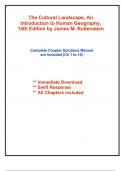Examen
Solutions for The Cultural Landscape, An Introduction to Human Geography, 14th Edition Rubenstein (All Chapters included)
- Cours
- Établissement
Complete Solutions Manual for The Cultural Landscape, An Introduction to Human Geography, 14th Edition by James M. Rubenstein ; ISBN13: 9780137917358. (Full Chapters included Chapter 1 to 14)....1.This Is Geography 2.Population & Health 3.Migration 4.Culture & Social Media 5.Languages ...
[Montrer plus]



